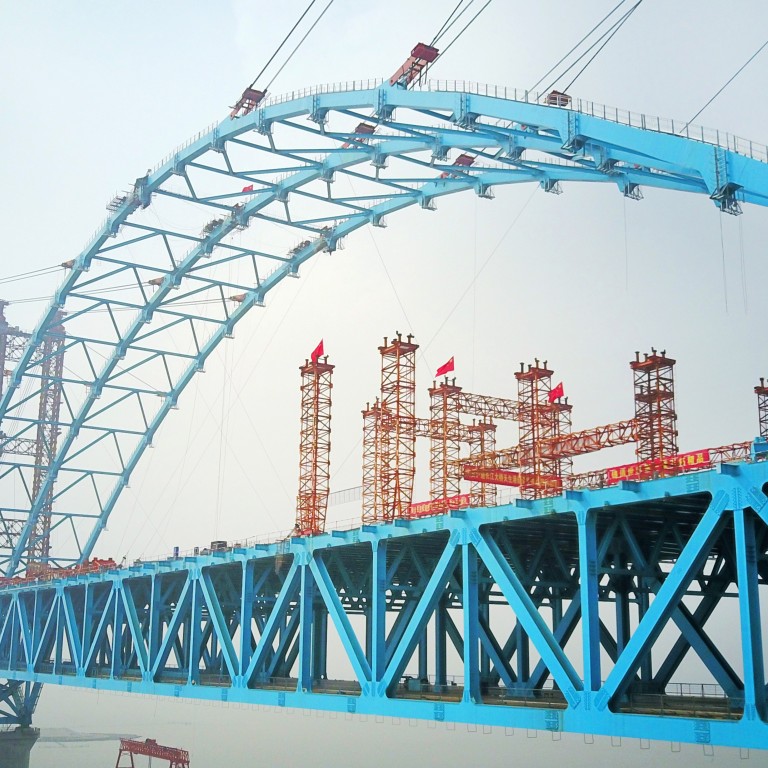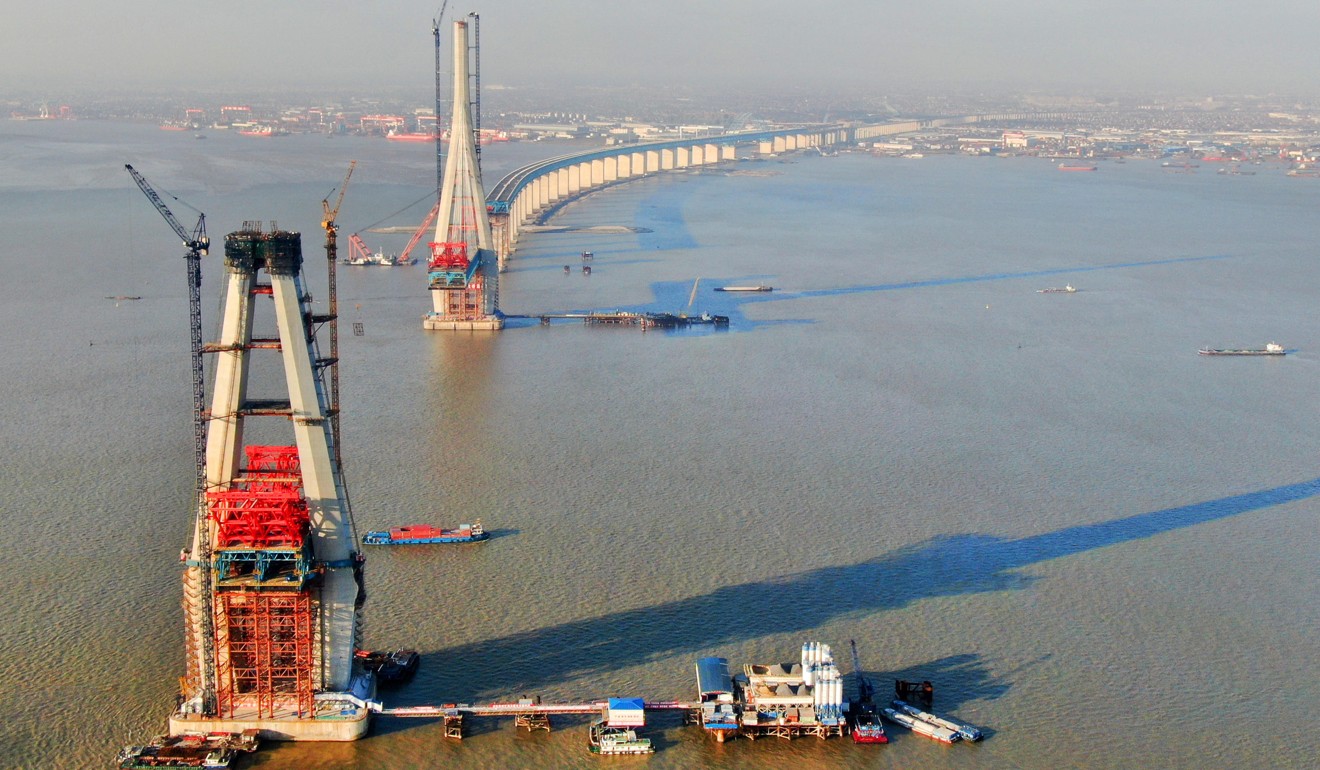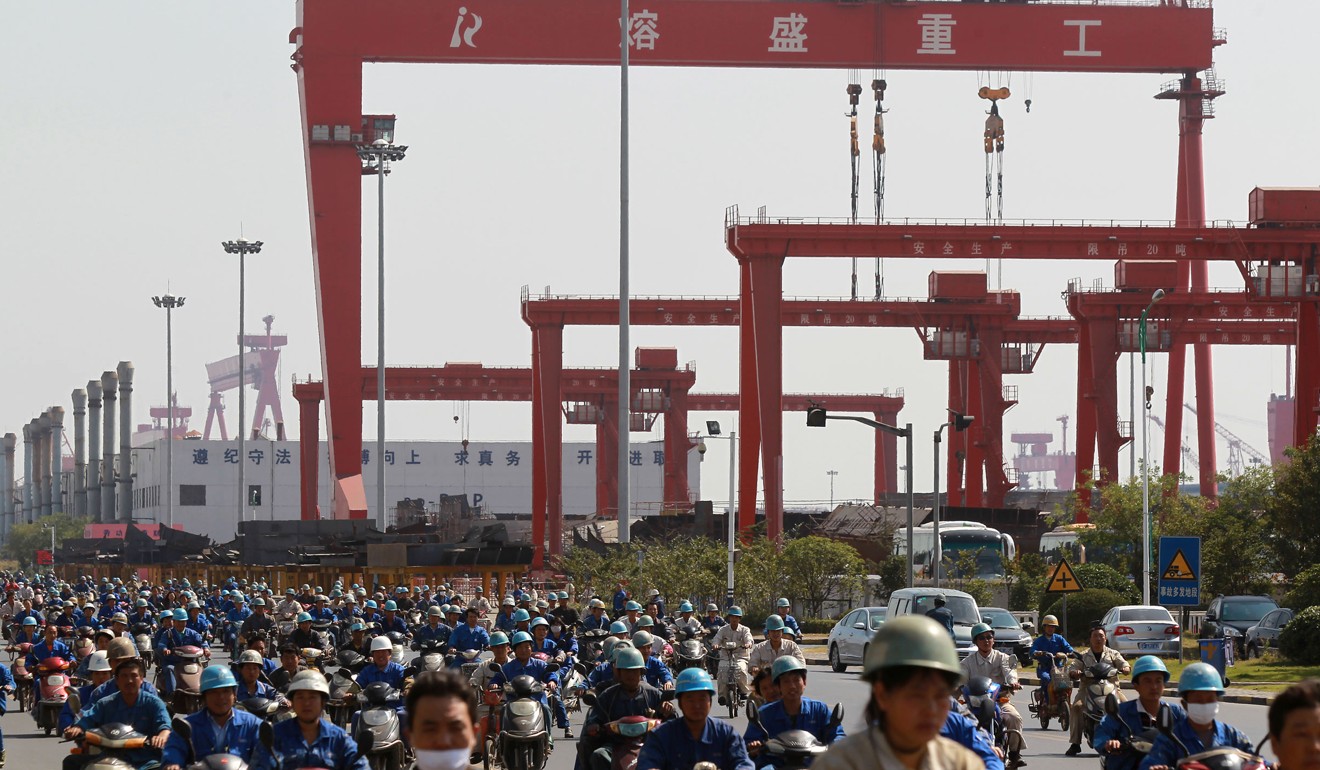
China’s Nantong dreams big with infrastructure projects to drive growth in economic downturn
- The Hutong Yangtze River Bridge will be four times the length of the Golden Gate Bridge in San Francisco, and is estimated to cost more than US$5.34 billion
- National Development and Reform Commission granted approvals for more than US$137.87 billion worth of projects in December to boost slowing economy
On a smoggy day in Nantong, an industrial town bordering Shanghai, workers are building the world’s longest railroad steel arch bridge, part of a multibillion-dollar investment to form a new economic zone around China’s financial hub.
The Hutong Yangtze River Bridge will measure 11,072 metres (38,393 feet) in length – four times that of the Golden Gate Bridge in San Francisco – and is expected to be completed this year.
While Nantong, 150km (93 miles) north of Shanghai in the eastern Jiangsu province, may not be the most well-known city in China, it is betting on an ambitious infrastructure spending programme spanning the next few years to help transform its sleepy economy.
The construction of the double-deck bridge, which is estimated to cost more than 36 billion yuan (US$5.34 billion) by the National Development and Reform Commission (NDRC), is mainly funded by the Jiangsu province itself and bank loans.
With China growing at its slowest pace in nearly three decades and fighting a trade war with the United States, questions have been raised whether the government’s conventional debt-fuelled investment model will be able to deliver the high-quality growth Beijing is striving for.

“These are amazing assets and the engineering is astounding, it does improve the quality of life, among other things,” said Dr Atif Ansar, a lecturer at Oxford University’s Saïd Business School, who led a team of researchers to examine the economic benefits based on a sample of 95 road and rail infrastructure projects in China between 1984 and 2008.
“But it’s the accumulation of debts within the state-owned firms and within the state-owned banking system.
“The concern is how the debt is going to be paid back. The process of deleveraging is quite painful, when the economy is slowing right at the time of the trade war.”
With fears of mounting risks in its financial system, China has made debt curbing a priority, and under the weight of the deleveraging campaign, infrastructure spending growth last year slowed to 2 per cent from 15 per cent in 2017.
It has rebounded over the past few months, and was up 8 per cent year on year in December alone as a result of policy easing, according to a report published by Australian investment bank Macquarie.
To boost growth, the NDRC has vowed to speed up approval of infrastructure projects and in December, granted approvals for more than 930 billion yuan worth of projects.
What are China’s top 10 infrastructure projects to rescue its slowing economy?
In January, the state planner announced another new railway project in Jiangsu, which will cost an estimated 218 billion yuan.
Lu Zhipeng, secretary of the Nantong Municipal Party Committee, told Xinhua last month that to develop the Yangtze River Economic Zone and for Nantong to become a key city in the “one-hour Shanghai economic zone”, it must be supported by a number of major projects.
“2019 will be the year for Nantong to bring these projects into life: promoting its industries, the city and its transport,” Lu said.
The city of over 7.2 million people, known among locals in the region for making bedlinen, saw its gross domestic growth drop to 7.2 per cent in 2018, from 7.8 per cent in 2017 and from over 15 per cent in 2005.
With a 2019 growth target of more than 7 per cent, Nantong’s ambition not only represents aspirations of smaller cities across the country, but also underscores China’s determination and prowess in infrastructure development to help move its economy up the value chain, shifting from mass manufacturing and heavy industries to high technology and services.
In theory, Nantong has what it takes – the services sector already made up half of Jiangsu’s GDP in 2017, while industries including petrochemical, information technology, car manufacturing, iron and steel, and power accounted for another 45 per cent.
In 2017, Jiangsu’s GDP hit 8.6 trillion yuan, which was larger than the economy of Indonesia and its population of 264 million.
China invests US$163.2 billion in infrastructure to stave off economic slowdown
It was the second-highest GDP recorded by a Chinese province, and contributed to about 10 per cent of China’s national total, according to a Moody’s report published last year.
However, Jiangsu is also China’s province with the most debt, with 1.2 trillion yuan outstanding in 2017, just below the debt ceiling of 1.3 trillion yuan set by the central government.
Its debt-to-GDP ratio of 14 per cent was also one of the lowest, reflecting the significance of economic growth in the region to fund its borrowing.
The province has over 5,000 state-owned firms, with liabilities of 4.5 trillion yuan, according to Moody’s.

But the Nantong government’s effort to breathe new life into its slowing economy appears to have yielded some initial success.
The Sutong Technology Industrial Park signed up 85 projects last year, receiving a total of 44 billion yuan of investment, according to the Nantong government.
A new theme park, costing 20 billion yuan, and featuring the Soviet aircraft carrier Minsk, is expected to begin construction this year, according to real estate and financial company Yongjia Group.
China’s largest property developer, Evergrande, is building the Hengda Haishang Venice resort, which will include a man-made beach with sand imported from the resort island of Hainan.
But Nantong’s expansion plans – lifting growth by building new infrastructure to link up with more established cities and economic regions – may not be effective for all secondary cities, warned Banny Lam, managing director and head of research at CEB International Investment.
Full speed ahead for China’s high-speed rail network in 2019
The Pearl River Delta, or the Greater Bay Area, is also betting on the closer proximity with more established regions like Hong Kong and Shenzhen to bring increased business to lesser developed cities in the northern and western areas of Guangdong.
“I think it really depends on the natural resources [in the region] and what they are aiming to achieve,” said Lam. “When there isn’t enough going, on these investments may not be meaningful.”
Ansar from Oxford University believes China needs to cut its reliance on infrastructure and reach out to both local and international technology firms to develop or commission projects that would add value to its economy and boost employment.
“The bottom line is you can’t deleverage too quickly. If you deleverage too quickly and suddenly bring down investment by 50 per cent, it can really crash the economy and cause a rapid recession,” he said.

